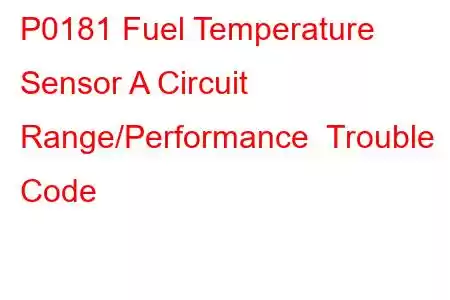P0181 Fuel Temperature Sensor A Circuit Range/Performance
OBD-II Trouble Code Technical Description
Fuel Temperature Sensor A Circuit Range/Performance
What does that mean?
This diagnostic trouble code (DTC) is a generic powertrain code, which means that it applies to OBD-II equipped vehicles (Nissan, Ford, Fiat, Chevrolet, Toyota, Dodge, etc.). Although generic, the specific repair steps may vary depending on make/model.
When I come across a code P0181, I know that it means that the powertrain control module (PCM) has detected a voltage signal from the fuel temperature sensor (or circuit) that is not within a programmed range. "A" refers to an area of circuitry as opposed to a particular circuit or component.
The fuel temperature sensor is typically integrated into the fuel composition sensor. Designed to provide the PCM with an accurate composition and fuel temperature reading, the fuel composition sensor is a small, computerized device placed in-line between the fuel tank and the fuel rail.
As fuel passes through the sensor, it is monitored to determine how much ethanol, water, and other contaminants are present. An electrical signal to the PCM reflects not only what contaminants are present but also to what degree the fuel has been contaminated. The level of contamination is measured according to the percentage of contaminants (to fuel) and is input to the PCM as square waveforms. The closer the waveform frequency, the higher the percentage of fuel contamination. Frequency could also be described as the vertical portion of the waveform. The fuel composition sensor measures the amount of ethanol present in the fuel differently than other contaminants. Fuel composition levels that are as high as eighty-five-percent ethanol are acceptable in flex fuel vehicles.
The pulse width, or the horizontal portion of the waveform, is indicative of fuel temperature. The broader the pulse width, the higher the temperature of the fuel passing through the fuel composition sensor. On most models, pulse width modulation varies between one and five-milliseconds (hundredths-of-a-second).
If the PCM detects an input signal from the fuel composition sensor, indicating that the fuel temperature is not within a programmed range or if the fuel temperature varies by a greater degree than expected from ambient temperature, a P0181 code will be stored and a malfunction indicator lamp (MIL) may be illuminated. Multiple ignition cycles (with a failure) may be required for MIL illumination in some applications.
Code Severity & Symptoms
Fuel temperature is monitored by the PCM to calculate fuel delivery strategy (in flex fuel vehicles) so this code should be treated as severe.
Symptoms of a P0181 code may include:
There may be no symptoms Other fuel composition codes may be present Possibly MIL illuminationCauses
Potential causes for this code to set are:
A bad ambient temperature sensor "A" Defective fuel temperature/composition sensor Faulty intake air temperature sensor Open, shorted, or damaged wiring or connectors PCM or a PCM programing errorDiagnostic and Repair Procedures
A good starting point is always to check for technical service bulletins (TSB) for your particular vehicle. Your issue may be a known issue with a known fix put out by the manufacturer and can save you time and money during diagnosis.
I would typically gain access to a diagnostic scanner, a digital volt/ohmmeter (DVOM), an oscilloscope, an infrared thermometer, and a vehicle information source like All Data DIY to diagnose a code P0181. A scanner with a DVOM and a portable oscilloscope (built-in) would serve you well.
A good place to start any diagnosis is with a visual inspection of all related wiring harnesses and connectors. All damaged or burnt components will need to be repaired or repla
Read: 45


